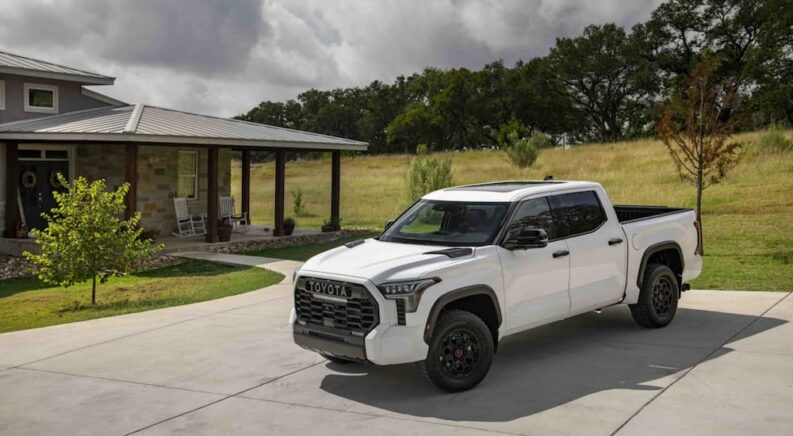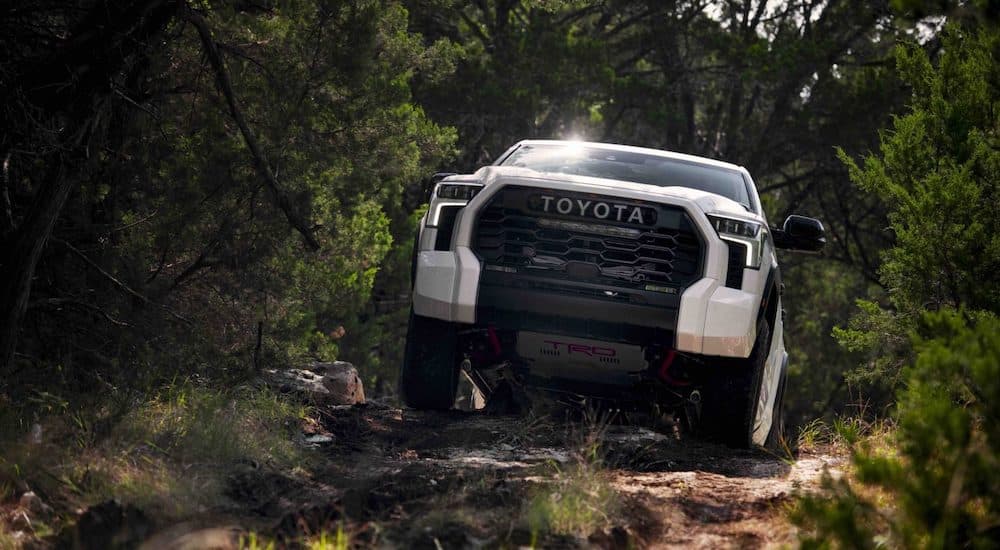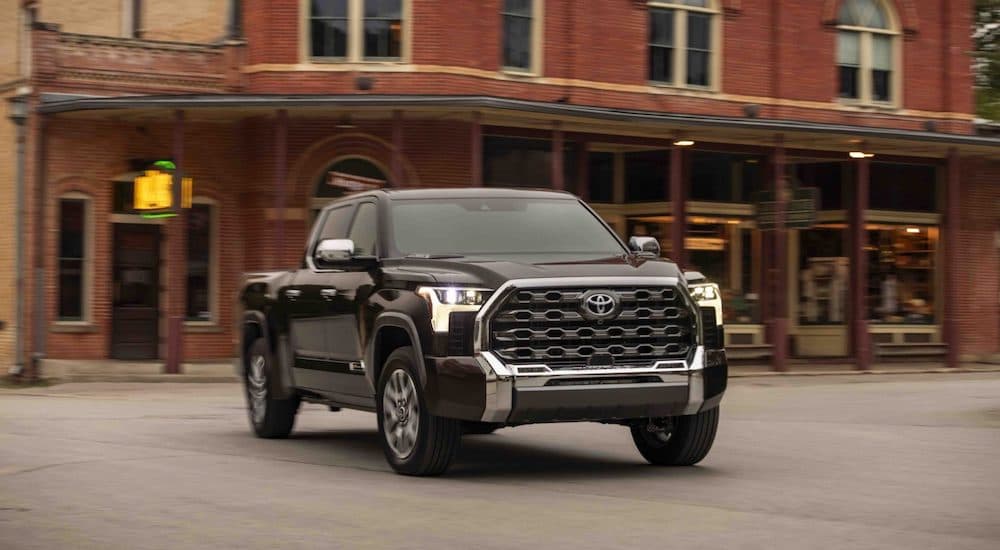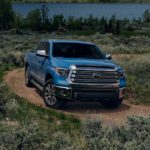Any conversation with truck owners that includes full-size trucks and fuel economy in the same sentence typically results in a lot of embarrassed looks and eyes nervously darting around the room or aimed at the floor in shame. We know. Full-size trucks don’t usually get the best gas mileage when you’re looking at powertrains that aren’t turbo-diesels. But that doesn’t mean all full-size trucks fall into that category. Heck, the F-150’s recent addition of a full-hybrid V6 has enabled it to break boundaries and offer more efficiency than its peers.
Toyota seems to be aiming to follow in Ford’s footsteps when it comes to the full-size Tundra. Sure, Toyota has the midsize segment on lockdown with the Tacoma, but it’s trailing behind the market leaders in the full-size segment. Creating enough separation from the competition to get people interested in Toyota trucks for sale beyond just the Tacoma required developing a model that would appeal to the full-size market in the same way that the Tacoma appeals to the midsize market.
Enter the Toyota Tundra i-FORCE MAX. Toyota’s ace in the hole. The ultimate trump card. The secret sauce on top of a light-duty hamburger. Introduced for the 2022 model year, the Tundra i-FORCE MAX represents Toyota’s attempt to marry reliable towing and hauling with a hybrid powertrain that delivers excellent fuel economy and range. The real bonus here is that it does so without being a turbo-diesel.
Maximizing Mileage With the i-FORCE MAX
If you’re wondering what’s the deal with this new powertrain, the quick rundown is that the Tundra i-FORCE MAX hybrid combines a twin-turbo 3.4-liter V6 internal combustion engine with an electric motor generator powered by a nickel-metal hydride battery pack. This combination manages to output 437 hp and 583 lb-ft of torque, which is quite impressive and puts it right there at the top of the offerings in the full-size segment compared to its competition from Ford, Ram, and Chevy.
Better yet, the i-FORCE MAX manages to maintain its high power output while also delivering impressive amounts of range. The estimated fuel economy for the 2024 Tundra i-FORCE MAX is 20 MPG in the city and 24 MPG on the highway in rear-wheel drive. If you opt to take advantage of the four-wheel drive iteration of the vehicle, it is rated for 19 MPG in the city and 22 MPG on the highway.
Initially, you might not think much of those numbers, and you might even be thinking that when the full-size truck and fuel economy conversation comes around again, you’ll be holding your head down in shame. But not quite. If you think about just how much power the Tundra i-FORCE MAX is generating and the amount of fuel economy you’re getting out of it in return, plus the towing and payload capacity, it actually puts the Tundra in a class of its own.
More Horsepower and Torque Than the Competition
It’s no surprise that the Tundra i-FORCE MAX powertrain readily outclasses full-size trucks like the Nissan Titan, but it also produces more horsepower and torque than the trucks from the big three. Sure, you can point to your Ford Raptor Rs and your Ram TRXs with their supercharged V8 engines, but if you’re just looking at the normal powertrain options, the Tundra is no slouch. In fact, the Tundra takes the cake compared to the gas-powered competition.
You might think this is an exaggeration, but the i-FORCE MAX has better specs than the GM 6.2-liter EcoTec3 V8, which tops out at 420 hp and 460 lb-ft of torque. It also has better specs than Ford’s 3.5-liter PowerBoost V6 Hybrid, which comes in at 430 hp and 570 lb-ft of torque. Finally, it outperforms the Ram 5.7-liter HEMI V8 with eTorque, which manages just 395 hp and 410 lb-ft of torque. And just for reference, the Nissan 5.6-liter Endurance V8 in the Titan generates 400 hp and 413 lb-ft of torque, which still comes up short against the i-FORCE MAX.
In short, the i-FORCE MAX really is a force to be reckoned with when it comes to performance comparisons with the competition. Compared to the trucks offered by Ford, Chevy, Ram, GMC, and Nissan, you can readily see how Toyota is aiming to be very competitive in the light-duty truck space. But the real hook is that when you compare the power output with the gas mileage of the competing trucks, you see that the i-FORCE MAX offers some noteworthy fuel economy in the segment.
Pushing Its Way to the Front With Efficiency
Compared to a turbo-diesel, the i-FORCE MAX isn’t much of a competitor in the fuel economy bracket. But the interesting thing about it is that when you look at its fuel economy ratings compared to the other gas-powered and hybrid truck models on the market, the i-FORCE MAX holds its own surprisingly well. Compared to the Silverado 1500, Sierra 1500, and Titan, the Tundra i-FORCE MAX has much better overall fuel economy.
The 2024 Silverado 1500 tops out at 18 MPG in the city and 22 MPG on the highway with its base 2.7-liter engine. Upgrading to the 6.2-liter V8 drops that to just 15 MPG in the city and 20 MPG on the highway. The 2024 Nissan Titan is just as bad at 15 MPG in the city and 21 MPG on the highway. Now, the Ram 1500 Pentastar V6 with eTorque does offer 20 MPG in the city and 25 MPG on the highway, but it loses out big time in the horsepower, torque, payload, and towing department.
The only comparison where the Tundra runs into a bit of trouble is with the PowerBoost V6 in the F-150, which is rated for 25 MPG in the city and 25 MPG on the highway. Out of all of the full-size options, the F-150’s PowerBoost V6 is the only gas-powered engine that has competitive performance and fuel economy when matched up against the i-FORCE MAX. But when you consider that the i-FORCE MAX still outperforms the F-150 in overall power output, it’s not a bad trade off. In fact, it’s an excellent trade off because it gives you fantastic performance and good fuel economy all in one.
Functionality and Utility, a True i-FORCE MAX Trademark
With its max trailering rating of 11,450 lbs, the Tundra i-FORCE MAX is more than capable of handling the towing jobs expected of a half-ton truck. But it’s not just about the total trailering capacity; it’s also about how it utilizes its functionality when under load. Thanks to features like the overhauled air-spring suspension in the rear and the digital driver display that shows some awesome telemetry like the charge rate and trailering capacity, the Tundra i-FORCE MAX offers a lot of great features for getting the most out of it when towing.
The Fast Lane Truck YouTube channel put the Tundra Capstone with the i-FORCE MAX to the test by pushing it to the limits on the Ike Gauntlet challenge, where it performed quite well with a 10,000 lb load. It happened to be one of the quietest half-ton pickups with the load it was carrying, and it was extremely stable. This makes it quite capable in its segment, especially looking at its stats when it comes to performance and utility capabilities.
A Competitive Light-Duty Truck
When you compare it to the other gas-powered half-ton pickups, you can see that the Tundra i-FORCE MAX offers a lot when it comes to power, capability, and fuel economy. In a vacuum, you might look at the fuel economy numbers of the i-FORCE MAX and scoff, but looking at the sum of its parts, you can see just how unique the Tundra i-FORCE MAX powertrain is compared to the rest of the market.
You get class-leading horsepower and torque, along with some of the best gas-powered fuel economy in the segment. Toyota should definitely see that as a win. Being able to truck through the Ike Gauntlet like a pro while packing on the extra weight of the battery pack sheds light on just how industrious the Tundra i-FORCE MAX is when it comes to its engineering. It’s definitely been a long time coming, but you can certainly tell that the i-FORCE MAX is here to stay and offers some competitive challenges to the current selection of half-ton pickups on the market.






